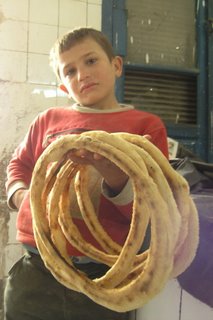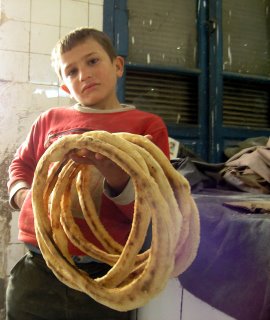A Food trip to ancient Antioch (Antakya)

I decided to spend some Frequent Flyer Miles and arranged a free ticket to Adana in Turkey. Here I rented a car and drove the 2 hours to Antakya.
I have been to many of the Turkish Provinces over the past 45 years, but not Hatay and I was looking forward to the experience.
I had heard about a new hotel that was recently converted from an old Ottoman period soap factory to a boutique hotel. I found the Savon Hotel (326-2146355) and was delighted. Truly an oasis in Antakya, not for everyone ($$$) but the comfort and professionalism of the hotel was exceptional.
I parked my car and hardly took it out for the next 3 days as Antakya is a walking city but that night, being tired from my air trip from Bodrum to Adana then driving to Antakya, I was going to just eat in the hotel. Instead, the hotel staff insisted I try the village of Harbiye about 7 km from Antakya center. I made the no turns, straight road drive from the Savon to the Kule Restaurant (326-2313092). Introducing myself to the owner Nurettin and explaining that I was alone in my search for the food treasures of his restaurant; he graciously sat me down at his table near the door where he occasionally rose to greet old customers.
This is what he served me: a double raki, zahtar salad, humus, sac orugu, icli kofte (stuffed meatball), biberli ekmek (bread with paprika), tuzlu yogurt (salty yoğurt) and lastly, peynirli irmik helvasi (semolina dessert with cheese).
Nurettin then told me to leave everything on the plates as he grabbed my hand and walked me to the kitchen where perhaps 40 staff was hard at work making the specialties of the restaurant. It was a sight to behold, almost out of the Middle Ages and was fascinating how chefs and helpers from perhaps 15 years of age to 60 years all worked in harmony with smiles and jokes being tossed around along with the zahtar. All of this seemed to be in keeping with the story that Apollo had fallen in love with Daphne right here in Harbiye.
The next morning I was up early and went walking down the street toward the Antakya main market called Uzun Carsi but I could not help myself from popping into a simit bakery a block from the hotel at #168 Kurtulus Cad.
Now, my grandfather was a baker and I know bread, but here again was something out of antiquity. A primitive wood burning oven, 2 bakers and 2 apprentices all turning out the most unique simit I have seen. A full 30 cm diameter and really tasty. I spent a good 2 hours with these fellows looking at how they made the dough, how they shaped and then using a primitive peel, placed each simit in the oven without losing the circular shape. Then on to Uzun Carsi which was probably in the same place since the time of Christ. I came across Mehmet Bilgin (326-2157386) where I managed to buy some local fantastic cheese varieties as well as a superb pepper salca (paste). Next to Mehmet was another cheese man who had additional varieties as well as other local salca's including pepper and tomato. All excellent.
Further in the center of the market, I discovered Ayhan Rifat Hubbezoglu (326-2151255). Their shop was prominent and in a few seconds they had me sitting behind the counter as if I was the boss. Tea in one hand and camera in the other I shot the most amazing photos of customers and passerby's.
Ayhan was wonderfully friendly and showed me his main product of dried zahtar, still a beautiful green in the huge cloth bags. He also had every herb and spice imaginable as well as a pekmez (grape molasses)of the type commonly found in nearby Kilis sold in hand made wood boxes but his was of spectacular quality and came from a small producer near Antalya. A 100% grape reduction that had become like crystallized honey, but as smooth as kaymak (cream). My mouth waters as I write this.
After 2 hours at their shop it was getting toward 1 pm and I mentioned I was off to lunch at a restaurant a friend had told me I should not miss. "Why do you want to go there now that it is 1 pm and all the food is finished" he said and he handed me a local Pide wrapped in white paper and ordered more tea. That was my lunch of the day but it was really special. Later, I saw many pide makers in Uzun Carsi. Using pide dough, instead if simply baking it off, they instead, have a mixture of local cheese, zahtar and red pepper salca that they smear on the dough before placing it in the oven. I must say it is unique, delicious and a meal in itself.
I walked through the Carsi and one could not help noticing the shalvar all the men wore, so naturally, I said "why not me". In the Uzun Carsi there is a Terziler Carsi (Tailor's Bazaar) and at shop #17 resides Ahmet Olmez. We chose the material, he measured me and in 2 hours I had my first pair of black shalvar with the center pleat reaching down to my ankles. The next thing I see, walking toward me, is this unusual man accompanied by a young boy. On a stick he supported about 15 vests and jackets all made of either leather or rustic cloth. Apparently, Antakya has a community of Afghan refugees whose sole occupation is making vests and jackets at ridiculously low prices with surprisingly good quality. I bought a fantastic old style vest for 5YTL. With the shalvar and the vest I was now really getting into the scene.
The next day, I walked the market and found a basket maker. I had to find a way to carry home what I was accumulating and did not want to add to my cheap luggage collection. I bought a one-meter high basket and hanging high above on a hook was a birdcage made from the basket material. I found that it made the perfect basket cover. I could now buy what I wanted, place it in the basket and cover it with the birdcage that fit in upside down. Back home now, I am really enjoying the use of both pieces.
One morning I arose and went out to find a specialty that my food writing friend, Tijen Inaltong told me to look out for. It did not take me long and across from the Antik Beyazit Otel (a nice alternative to the Savon at a much lower price) there was the sign on the window. "HALEPLI IBRAHIM USTA - BAKLA VE HUMUS EZMESI" (Master Ibrahim from Halep -mashed broad beans and humus).
Ibrahim is a character and after having spent a few years working for the famous ezme makers in Halep, he decided to come back home and open his own place. I must say, I fell in love with his product. He makes every order by hand using a wood pestle to mash all the ingredients together. After a full dish of the bakla and then a full dish of the humus ezmesi, I almost had to be carried out of the place. One added note. If you want to learn about the history of Antakya and its local politics, (according to Ibrahim), you will have come to the right place.
Of course, I am not going to come to Antakya without visiting historic places and I must say the Mosaic Museum was superb and alone, worth the trip. A morning visit to St. Pierre Grotto, where Christianity was supposedly founded, was unique as I was the only one there. The watchman invited me into his room for tea and we chatted for an hour. A visit to Titus Tunnel, just past Samandag was an outstanding afternoon trip. As I climbed into the hills there, I looked through the bay trees to see Ismail and his donkeys. He was cooking something and the smell was ambrosia. Approaching him I could see he was boiling huge quantities of bay leaves. He used an enormous copper pot that he heated with the branches of the bay tree and within 24 hours he was skimming off the bay oil that formed on the top. He explained that he did this every year with his family, the women and children picking the bay leaves but he had to maintain the fire under the pot for days at a time, sleeping in the open, until they decided they had accumulated enough oil. The oil went to the Antakya soap makers to make natural olive oil soap with bay oil.
My last experience was with Metin Tansal who owns a restaurant called Sultan Sofra (326-2138759). Now if you truly love food, you will think you died and went to heaven when you dine at his restaurant. At the restaurant, he sells a book that I bought called Hatay Halk Bilimi 2 written by Mithat Kalaycioglu. What a gold mine of a book! Everything you ever wanted to know about Hatay is in this book and the food section is really good. Metin's restaurant is an oasis of excellent food. He is one of those fellows who understand not only quality but also the need to preserve food culture. Just go in and point to what you want and everything is a gem of Antakya's cuisine rarely seen in other restaurants. After my feast, Metin took me by the hand and walked me around central Antakya showing me the small hidden (http://www.tribalmania.com/en) streets and a beautiful mosque sitting next to a church and a Jewish temple. He showed me renovated Ottoman homes and also some that were unrestored.
In summary, for me, Antakya was well worth the trip. Antioch…….such an old name and who would have thought that I could go there and not only fill my eyes but also fill my stomach with such beautiful things. It is truly a difference place steeped in antiquity with their own language, folklore, cuisine and so much more. The people are very special and caring and it is one of the few places that someone will take you by the hand and walk you to the address you had asked him directions for. Never mind that he just walked a kilometer with you to find it! That's everyday life in Antakya.


